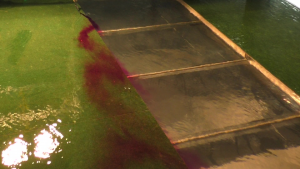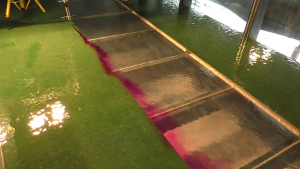Problematic issue
The aim is to understand what are the conditions of emergence and development of Kelvin-Helmholtz-type coherent structures (KHCSs) in shallow shear flows for three types of geometries:
- an open-channel with a rectangular section
- a composite open channel (rectangular section with a lateral variation in bed roughness)
- a compound open-channel (main channel + adjacent floodplains) .
We recall that KHCSs are large coherent palnform coherent structures with a vertical axis, very efficient for transversely exchanging the amount of longitudinal movement.
(Left) Kelvin-Helmholtz instability with the emergence of KHCSs. (Right) Low instability without formation of spiral-shaped vortices. Proust and Nikora (2020)
Key issues
- What is the effect of the vertical flow containment (i.e., water ldepth D) on the emergence and development of KHCSs?
- What is the effect of the relative submergence D/cf (cf = Darcy-Weisbach roughness coefficient) or the bed-briction number S on the emergence and development of KHCSs?
- What is the effect of dimensionless shear λ = (U2-U1)/(U2+U1) on the emergence and development of KHCSs?
- What is the combined effect of these different parameters for sheared flows in:
- A ‘single’ open-channel with a rectangular section with a smooth bottom
- A ‘single’ open-channel with a rectangular section with a rough bottom
- A composite channel (rectangular section with lateral change of roughness from smooth to rough)
- A compound channel (main channel + adjacent floodplains)
Methodology and example of result
The single and composite channel experiments are conducted in an 18m x 2m channel with a fixed slope. The first three geometries mentioned above will be studied with different flow confinements (i.e. total discharge Q associated with water depth D in a uniform planar regime), and shear values λ = (U2-U1)/(U2+U1) at the flume entrance varying from 0.1 to 0.7.
We present below the effect of the parameter λ on the maximum Reynolds tensor observed in a cross section, and on the appearance of quasi-2D structures (KHCs) in the case of flows previously studied in two compound channels (Proust et al. 2017). The emergence of KHCSs is in this particular case strongly controlled by λ, without influence of vertical confinement (relative flow depth Dr) in the range of Dr studied (from 0.2 to 0.4).
The single and composite channel experiments should lead to a broader understanding of the influence of D, D/cf and λ on the occurrence of KHCSs in sheared free surface flows.

Emergence and fate of the KHCSs after Proust, S., Berni, C., & Nikora, V. (2022)
Partner
University of Aberdeen, King’s college.
Publications
- Proust, S., Berni, C., & Nikora, V. (2022). Shallow mixing layers over hydraulically smooth bottom in a tilted open channel. Journal of Fluid Mechanics, 951, A17. doi:10.1017/jfm.2022.818
- Proust, S., Nikora, V.I. – 2020. Compound open-channel flows: effects of transverse currents on the flow structure. Accepted for Journal of Fluid Mechanics. 885 (A24) https://doi.org/10.1017/jfm.2019.973
- Proust, S. and V. I. Nikora (2018). Flow structure in compound open-channel flows in the presence of transverse currents. River Flow 2018: 9th International Conference on Fluvial Hydraulics 05/09/2018-07/09/2018, Lyon, FRA. E3S Web Conf. 8 p.
- Proust, S., J. N. Fernandes, J. B. Leal, N. Rivière and Y. Peltier (2017). Mixing layer and coherent structures in compound channel flows: effects of transverse flow, velocity ratio and vertical confinement. Water Resources Research, 53(4): 3387–3406.
- Proust, S., Nikora, V.I. – 2017. Coherent structures in compound channel flows at the presence of transverse currents. 4th International Symposium of Shallow Flows 26/06/2017-28/06/2017, Eindhoven, NLD. 4th International Symposium of Shallow Flows. 3 p.




